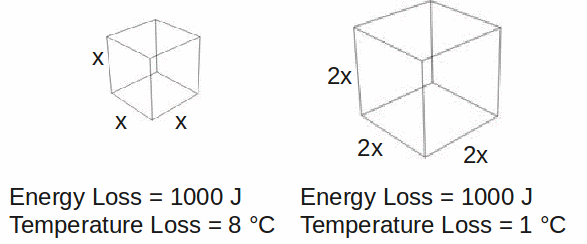For living beings the relative scaling of a physical quantity is often more important than the size of the quantity. For example, when administering a medicine, the dose will often depend on the weight of the object, or maybe their age. This is especially important when administering doses to children. Administering the same dose to a child as to an adult might be to administer a dangerous amount. Administering a child's dose to an adult might be ineffective, but the dose itself would not be dangerous.
Animals have to control the rate of thermal energy loss. This scales as the square of length or height. Actually the absolute rate of energy loss is not as important as the rate of energy loss per unit mass, since this determine how fast the animal cools and hence it's temperature. The box below left loses 1000 J of energy, the temperature dropping by 8 °C as a result. When the block below left loses the same amount of energy, it's temperature drops by only 1 °C, because this box is eight times as big and has eight times the mass.

For small animals, a small heat loss can result in a large temperature change, determined by the heat loss per unit mass. The rate of loss of heat is proportional to the surface area,![]() but the rate of heat loss per unit mass is given by
but the rate of heat loss per unit mass is given by![]() If the length or height of an animal is halved, the rate of heat loss doubles and vice versa.
If the length or height of an animal is halved, the rate of heat loss doubles and vice versa.
Similar analysis gives the bone stress per unit area as proportional to![]()
and oxygen absorption rate per unit mass is proportional to![]()
